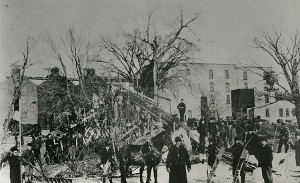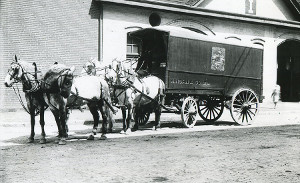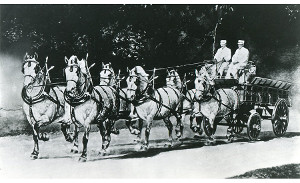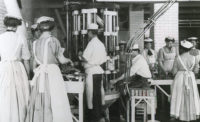The following dates reference some industry and publication highlights during The National Provisioner’s first 25 years in business.

1890s
- Artificial ice making and refrigeration equipment was new but catching on. Until that time, natural ice cooling was the norm. Before artificial cooling technology was adopted, crushed ice was primarily used to cool down meat railroad cars.
1891
- April 11: The premiere issue of The National Provisioner (NP) was published in New York.
- Industry was processing byproducts inside the packinghouse.
- U.S. beef exports totaled 395,540,000 pounds; pork, 671,222,000 pounds; lard, 498,344,000 pounds; and cattle, 12,000 head.
- May 12: First federal meat inspection began at the Eastman & Co. abattoir in New York on cattle for export.
Additional Content:
Bryan Salvage details the first 25 years - Read Now
Guest column by Rosemary Mucklow - Read Now
1892
- Meat packers began saving byproducts for pharmaceutical and medical uses.
- First long-distance shipments of chicks from production areas such as New Jersey to the Midwest Chicago area.
1893
- May 1: The 1893 World’s Fair, also known as the World’s Columbian Exposition, opens in Chicago, Ill. NP urged the American meat industry to attend and participate.
1895
- May 4, in NP: American-made lard is a major domestic and international product.
1896
- Charles Cypher introduces an incubator with a capacity of 20,000 eggs.
1897
- The Amalgamated Meat Cutters & Butcher Workmen of North America (AFL-CIO) founded.
1898
- April 25: Spanish-American War — The United States declares war on Spain. During this brief war, which ended on Dec. 10, 1898, U.S. troops were supplied with refrigerated meats for the first time, along with standard canned meats.
1899
- Sept. 23, in NP: Admiral of the U.S. Navy George Dewey (only one to attain that rank and a hero at this time) said American meat “can lick the world.”
1900
- Cure pumping devices begin use.
- On-rail smokehouse trees were created and mechanical bacon slicing equipment was launched.
- Experiments reveal nitrite as an active ingredient in meat curing.
- Hog cutting conveyorized tables being used while viscera inspection also begins.

1901
- Jan. 3: The U.S. Census estimates the U.S. population at 70 million.
1905
- Land Grant universities begin to apply scientific principles on poultry production and disease prevention/control in earnest.
1906
- Feb. 28: Upton Sinclair publishes “The Jungle.”
- June 30: The U.S. Congress passes the Meat Inspection Act and Pure Food and Drug Act.
- June 30: American Meat Packers Association created to address packing challenges. Name changed to Institute of American Meat Packers in 1919; American Meat Institute in 1940; and finally to the North American Meat Institute in 2015, with the merger between the American Meat Institute and the North American Meat Association.
1907
- Experiments at the University of Wisconsin prove the nutritional value of grains for improved animal feeding.
- Hybrid corn and packinghouse byproducts developed for feed additives.
1908
- April 25, in NP: NP published the first article in a comprehensive series explaining the new federal meat inspection.
1909
- Aug. 14, NP: Cold-storage meat test results at the University of Illinois show refrigeration increases digestibility of meat.
1910
- Farmers developed capons to have the dual-purpose chickens produce a meatier bird. Most popular breeds were Leghorns and Rock Islands. Barnyard flocks were typically 20 to 50 chickens. Production was seasonal because poultry needs sunshine.
- March 18, in NP: Recent average prices per pound for various meat cuts in Chicago: Sirloin steak, $0.20; round, $.0.14; mutton loin chops, $0.18; veal leg, $0.15; and pork loin, $0.16.
- Dec. 17, in NP: Undrawn poultry decomposes slower than poultry that has been either partly or wholly eviscerated, based on practical tests made by government experts.
1911
- Feb. 23, in NP: NP urges packers to take immediate steps to stop rough handling of livestock from live animal chutes. First article in a series.

1912
- March 9, in NP: Bureau of Animal Industry suggests packers consolidate slaughtering for each neighboring community into one slaughterhouse to improve efficiencies and lower costs.
1913
- June 21, in NP: Terms of the federal food and drugs act were extended to allow more effective supervision over meat products after they leave a packer’s hands and are in distributing and retail channels.
- Oct. 25, in NP: Testing of Argentine beef by many concerns underway in U.S. markets
1914
- Sept. 26: The Federal Trade Commission Act creates the U.S. Federal Trade Commission (FTC).
1915
- July 17, in NP: New Armour plant near La Plata, Argentina, opens. This $3.5 million investment offers a daily kill capacity of 1,500 cattle, 2,500 sheep and 1,000 hogs. Seventeen buildings were built on 24 acres. Some were six stories tall.
1916
- Meat-grading standards developed to give steamship companies comprehensible terms for determining the meat quality of products they buy.
- Dec. 23, in NP: The highest price on record for Christmas beef was paid at the International Livestock Exposition in Chicago at the auction sales of championship winners. The grand champion steer — “California Favorite,” a crossbreed Hereford-Shorthorn calf about 14 months old weighing 1,130 pounds live weight bought by Frank J. Sullivan for the Sullivan Packing Co., Detroit, Mich. — was sold for $1.75 lb.
Our Meat Industry Timeline continues in July, with the events and moments from 1917-1941 — Part 2 of The National Provisioner’s 125th Anniversary celebration.




Report Abusive Comment